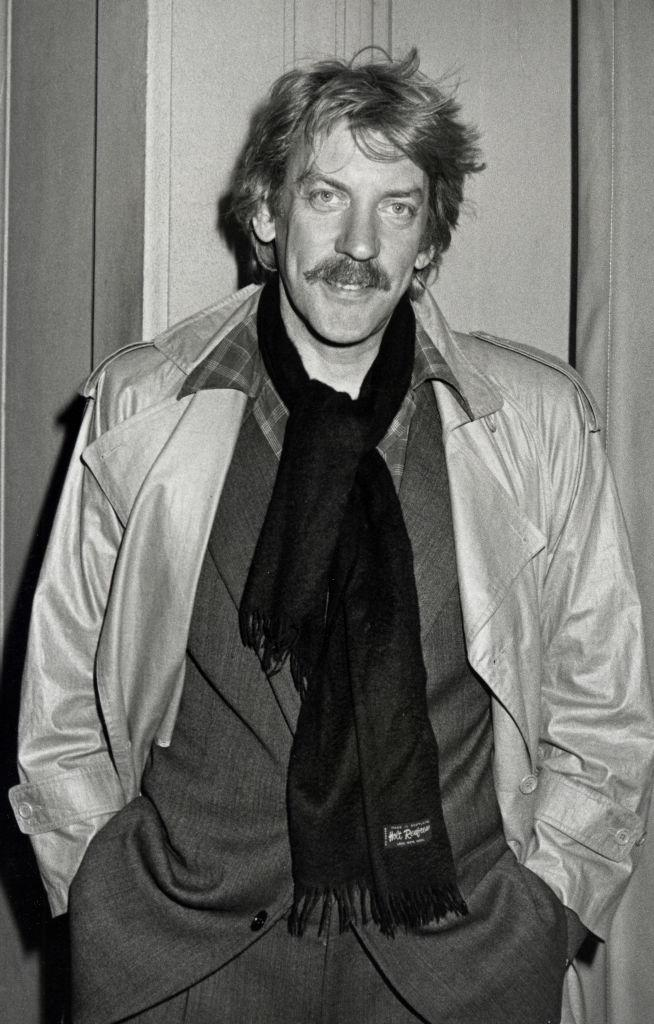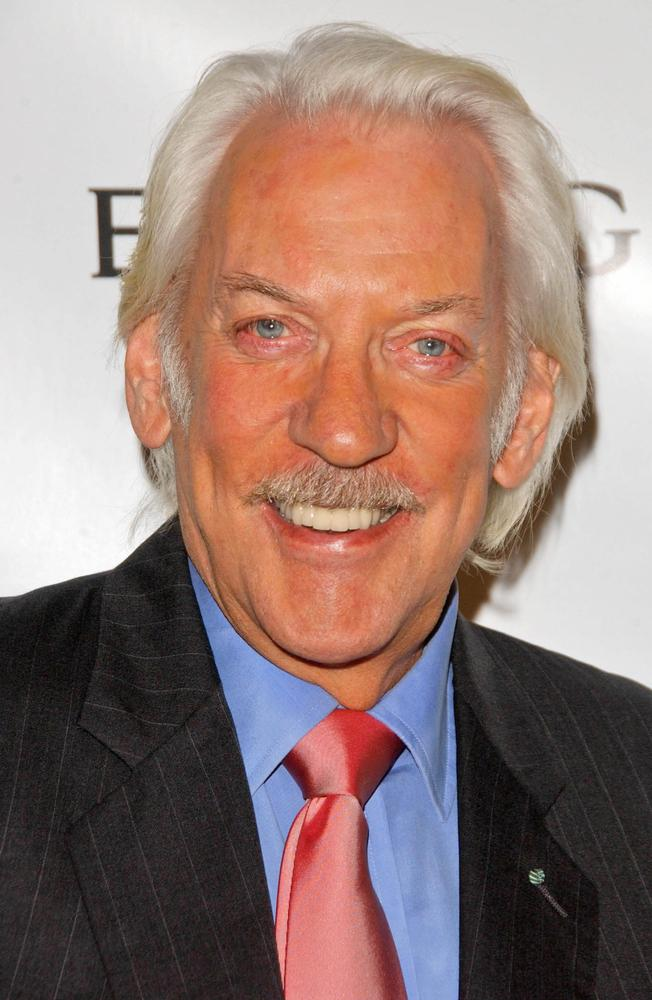Sutherland was born July 17, 1935 in New Brunswick, Canada, later moving to Bridgewater, Nova Scotia. Throughout his childhood he battled a number of serious illnesses including polio, rheumatic fever and spinal meningitis.
He left Canada to pursue an interest in acting at the London Academy of Music and Dramatic Art, and soon found work in TV and low-budget films.
He got a Hollywood breakthrough in the classic war film The Dirty Dozen, whose ensemble cast includes Lee Marvin, Charles Bronson, Ernest Borgnine and Jim Brown. It was the fifth highest grossing film of 1967.

After leaving London for Hollywood, Sutherland landed one of his most iconic roles in the 1970 anti-war comedy-drama MASH, originating the role of “Hawkeye” Pierce. MASH was one of the most successful films of the decade and is regarded as a classic.
Throughout the ’70s, Sutherland was a Hollywood leading man: his films include in the Oscar-winning Klute opposite Jane Fonda, the psychological horror Don’t Look Now, and the remake of Invasion of the Body Snatchers. He also appeared in the hit comedy Animal House.
In 1980, he starred in Robert Redford’s Ordinary People, which won the Academy Award for Best Picture. Other major films include Backdraft, JFK, Six Degrees of Separation, The Italian Job and Pride and Prejudice.

Sutherland also had success on TV, winning an Emmy Award for the 1995 film Citizen X, and a Golden Globe for the television film Path to War.
A younger generation of moviegoers was introduced to Sutherland through The Hunger Games, the hit dystopian blockbuster series: Sutherland starred as the villainous President Coriolanus Snow.
Though he surprisingly never received an Oscar nomination, he received an Academy Honorary Award in 2017, “for a lifetime of indelible characters, rendered with unwavering truthfulness.” He also received a star on the Hollywood Walk of Fame in 2011, and on the Canadian Walk of Fame in 2000.

Sutherland was married three times; he was married to actress Francine Racette for 52 years until his death. He was previously married to Lois May Hardwick and Shirley Douglas, and also had an affair with his Klute co-star Jane Fonda.
He had five children — including most famously his son Kiefer Sutherland, the actor best known for playing Jack Bauer in 24.
”I was too young to go watch my father’s films in the cinema,” Kiefer Sutherland told The Hollywood Reporter in 2017. “By the time I hit 20, VHS was available and a friend of my fathers had a lot of his films. In three days I watched Don’t Look Know, Klute, M*A*S*H, Kelly’s Heroes, 1900 and Fellini’s Casanova.”
“It was such a wide spectrum of characters, and I remember calling him up and I felt really badly that I grew up not knowing what a profoundly special actor he was, I felt horribly guilty of that. As a young actor, I had never known or seen another actor who’ve done characters so diverse either.”

Rest in peace to the iconic actor Donald Sutherland who lent his talents to so many great, classic movies — you will be missed 💔😢
Big and Beautiful: Plus Size Becomes the New Average for American Women
Social Media’s Role in Redefining Beauty Standards
Social media has revolutionized nearly every aspect of modern life, and its influence on beauty standards is no exception.
For decades, beauty ideals for women have been narrowly defined. From Marilyn Monroe’s curvaceous figure in the 1950s to the ultra-thin frames of 1990s supermodels, society’s idea of the “perfect” body has shifted over time. However, a consistent theme has been the pressure on women to conform to a singular standard, often dictated by pop culture and advertising.
In contrast, social media has significantly expanded the definition of beauty. Platforms like Instagram, TikTok, and YouTube now feature creators of all sizes, shapes, and ethnicities. This inclusivity is reshaping how people view their bodies, offering representation that goes far beyond the size 0 models traditionally seen in mainstream media.
Plus Size Becomes the New Norm
As American women increasingly embrace body positivity and size inclusivity, research shows that the average body size is also changing.
A study published in the International Journal of Fashion Design, Technology and Education highlights a shift in what is considered “average.” While it was once commonly stated that the average size for American women was 14, the study reveals that the average woman now wears between a misses size 16 and 18, which corresponds to a women’s plus size 20W. Additionally, the average waist size has increased from 34.9 inches to 37.5 inches over the past two decades.
“We hope this information reaches both the industry and consumers,” said Susan Dunn, one of the study’s lead researchers, in an interview with Today. “Understanding these figures can have a profound impact on women’s self-esteem. The apparel industry needs to recognize that these women are here to stay and deserve inclusive clothing options.”
Why Are American Women Getting Larger?
The average size of American women has increased over the past several decades. According to the CDC, the average weight of an American woman is now approximately 170.6 pounds, compared to 140 pounds in the 1960s. Multiple factors contribute to this trend:
- Lifestyle Changes: Sedentary jobs, higher calorie consumption, and an increased reliance on processed foods play significant roles.
- Cultural Shifts: Greater acceptance and celebration of diverse body types have reduced societal pressure to adhere to extreme dieting.
- Genetics and Environment: Genetic predispositions and environmental factors, such as stress and access to healthy foods, also influence body size.
Beyond Appearance: A Health Perspective
While larger body sizes are increasingly celebrated, the medical implications cannot be ignored. Obesity rates have doubled since 1990, according to the World Health Organization. Social media, while fostering inclusivity, has also been criticized for promoting unhealthy lifestyles and sedentary habits that contribute to weight gain.

The Mayo Clinic emphasizes that “obesity isn’t just a cosmetic issue.” It is a medical condition that increases the risk of numerous health complications, including heart disease, diabetes, high blood pressure, high cholesterol, liver disease, sleep apnea, and certain types of cancer.
A New Era of Beauty
True beauty lies in celebrating individuality rather than conforming to a rigid standard. Social media has been instrumental in spreading this message and has the potential to reshape beauty norms in a positive way when used thoughtfully.
What’s your take on social media’s impact on beauty standards? Share your thoughts and pass this article along to gather more perspectives!




Leave a Reply